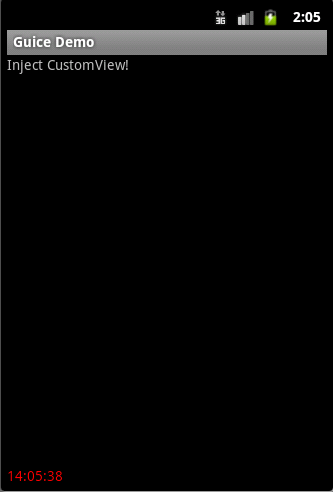Android RoboGuice2 使用指南(3): Inject 自定义View
前面介绍了Android RoboGuice2 的HelloWorld示例,并介绍了从RoboGuice 1.1 升级到RoboGuice2.0 的主要注意事项。其它的基本概念和RoboGuice1.1基本一样,可以参见
Android RoboGuice 使用指南(3):Bindings 概述Android RoboGuice 使用指南(4):Linked BindingsAndroid RoboGuice 使用指南(5):Binding AnnotationsAndroid RoboGuice 使用指南(6):Instance BindingsAndroid RoboGuice 使用指南(7):@Provides MethodsAndroid RoboGuice 使用指南(8):Provider BindingsAndroid RoboGuice 使用指南(9):Untargetted BindingsAndroid RoboGuice 使用指南(10):Just-in-time BindingsAndroid RoboGuice 使用指南(11):ScopesAndroid RoboGuice 使用指南(12):如何绑定generic类型Android RoboGuice 使用指南(13):RoboGuice 功能描述Android RoboGuice 使用指南(14):Inject ViewAndroid RoboGuice 使用指南(15):Inject ContextAndroid RoboGuice 使用指南(16):Standard InjectionAndroid RoboGuice 使用指南(17):Inject ExtraAndroid RoboGuice 使用指南(18):Inject ResourcesAndroid RoboGuice 使用指南(19):发送接收Events本例介绍如何Inject自定义的View,Inject自定义的View和Android自带的View(如TextView,Button)方法一样。
本例使用一个自定义的TextView,每隔1秒显示当前时间。前定义如下:
//--------------------------------- PACKAGE ------------------------------------package com.pstreets.guice.customview; //--------------------------------- IMPORTS ------------------------------------import android.content.Context;import android.os.Handler;import android.util.AttributeSet;import android.widget.TextView; import java.util.Calendar;import java.util.Date; public final class TimeTextView extends TextView { public TimeTextView(Context context, AttributeSet attrs) { super(context, attrs); postDelayed(mUpdateView, mRepeatTimePeriod); } private void setTimeString() { Calendar c = Calendar.getInstance(); Date currentTime = c.getTime(); String timeString = formatTime(currentTime); setText(timeString); } private Handler mHandler = new Handler(); /** * one second. */ private int mRepeatTimePeriod = 1000; private Runnable mUpdateView = new Runnable() { @Override public void run() { TimeTextView.this.setTimeString(); // Force toggle again in a second mHandler.postDelayed(this, mRepeatTimePeriod); } }; private String formatTime(Date time) { int hours = time.getHours(); int miniutes = time.getMinutes(); int seconds = time.getSeconds(); String ret = ""; if (hours < 10) { ret += "0"; } ret += hours + ":"; if (miniutes < 10) { ret += "0"; } ret += miniutes + ":"; if (seconds < 10) { ret += "0"; } ret += seconds; return ret; } }修改main.xml
<?xml version="1.0" encoding="utf-8"?><LinearLayout xmlns:android="http://schemas.android.com/apk/res/android" android:orientation="vertical" android:layout_width="fill_parent" android:layout_height="fill_parent" ><TextView android:id="@+id/hello" android:layout_width="fill_parent" android:layout_height="wrap_content" android:text="@string/hello" /><TextView android:layout_width="fill_parent" android:layout_height="0dp" android:layout_weight="1.0" /><com.pstreets.guice.customview.TimeTextView android:id="@+id/txtTime" android:layout_width="fill_parent" android:layout_height="wrap_content" /></LinearLayout>
定义该TimeTextView的id为txtTime。
这样可以在对应的Activity中使用InjectView 来给对应的txtTime 自动赋值(注入)。
@ContentView(R.layout.main)public class GuiceDemo extends RoboActivity { @InjectView (R.id.txtTime) TimeTextView txtTime; @Override public void onCreate(Bundle savedInstanceState) { super.onCreate(savedInstanceState); txtTime.setTextColor(0xFFFF0000); } }
由于GuiceDemo是从RoboActivity派生的,在onCreate 第一行的super.onCreate() 完成注入功能。如果你对RoboGuice1.1 熟悉的话,在使用注入的变量前如txtTime,需要执行setContentView。
在RoboGuice2.0中你可以使用同样的方法,2.0还提供了一个简单的标注方法@ContentView ,如本例,为Activity设置ContentView。

本例下载 。
从本例可以看出,和RoboGuice1.1 相比,RoboGuice2.0在使用上要简洁的多。本例只需从RoboActivity派生,不在需要定义Application等